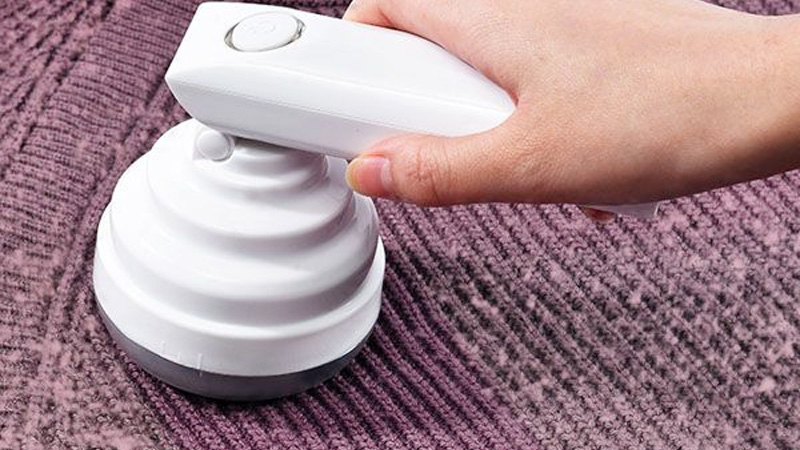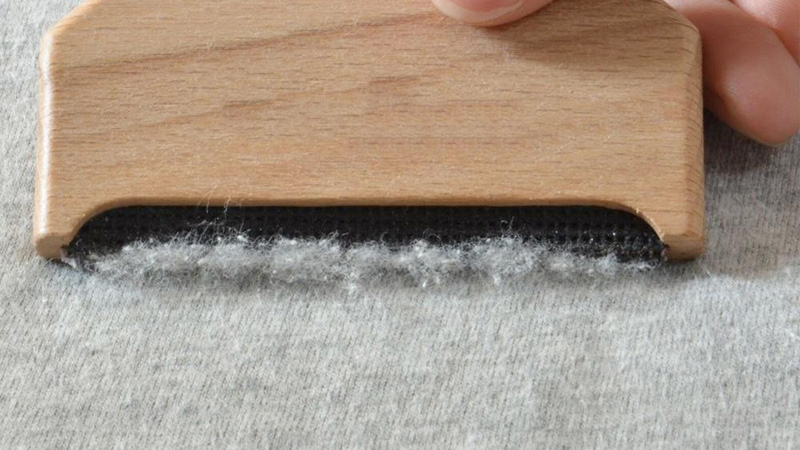Cashmere, known for its unparalleled softness and luxurious feel, is a cherished addition to any wardrobe. However, even the finest cashmere garments can fall victim to a common issue: pilling.
Those unsightly little balls of fiber can quickly detract from the elegance of your cashmere pieces. But fear not! With the right care and attention, you can keep your cashmere looking pristine and pill-free for years to come.
So, how to prevent cashmere pilling? In this guide, we’ll explore the causes of cashmere pilling and provide you with a comprehensive set of tips and tricks to prevent it. From selecting high-quality cashmere to proper storage and maintenance, we’ve got you covered.
Say goodbye to those pesky pills and hello to a longer-lasting, more luxurious cashmere wardrobe. Let’s dive into the art of preserving the beauty and softness of your beloved cashmere garments.

How to Prevent Cashmere Pilling?
Before we dive into prevention methods, let’s first understand what cashmere is and why it pills. Cashmere comes from the soft undercoat of cashmere goats, which is finer and softer than regular wool.
Its fine fibers create the luxurious feel that cashmere is known for. However, these delicate fibers can be prone to pilling due to friction and wear. Let’s expand on the prevention methods for keeping your cashmere garments pill-free:
Choose High-Quality Cashmere
When purchasing cashmere, invest in quality. Look for reputable brands and check the fiber’s thickness and feel. High-quality cashmere is less likely to pill, and it will also last longer.
Avoid wearing the same cashmere garment too frequently. Give it time to rest between wears to allow the fibers to recover. This can significantly reduce friction-induced pilling.
Proper Washing and Care
Follow these steps to care for your cashmere properly: Hand washing is the gentlest method. Use lukewarm water and a mild detergent specifically designed for delicate fabrics. Avoid vigorous scrubbing or wringing. Instead, gently agitate the water to clean the garment.
Rinse with cool water until all detergent is removed. Lay your cashmere flat on a clean towel to dry. Avoid hanging it, as this can cause stretching and deformation. When storing your cashmere, fold it neatly to prevent stretching at the shoulders.
Use a Fabric Shaver or Sweater Stone
To deal with existing pills, invest in a fabric shaver or sweater stone. These tools can safely remove pills without damaging the fabric.
To safeguard your cashmere from moths, store it in airtight containers or use moth repellents like cedar blocks or lavender sachets in your drawers and closets.
Avoid Friction
Be mindful of how you wear your cashmere. Avoid carrying heavy bags with sharp edges that can rub against the fabric. Be cautious when wearing jewelry that might catch on your cashmere.
Layering your cashmere with other clothing can help reduce friction between cashmere and other materials.
Avoid Wearing Sharp Accessories
Be cautious when accessorizing items like belts, watches, or handbags with sharp edges or rough surfaces. These accessories can rub against your cashmere, causing friction and pilling.
Opt for smooth and rounded accessories when wearing cashmere to minimize this risk.
Layer with Smooth Fabrics
When wearing your cashmere, consider layering it with smooth, non-abrasive fabrics like silk or satin. These materials create a protective barrier between your cashmere and other potentially abrasive surfaces, reducing the chances of pilling.
Use a Garment Bag
When traveling with your cashmere garments, use a breathable garment bag to protect them from friction, dust, and potential snags. This extra layer of protection will help maintain their pristine condition during transit.
Regularly Inspect and De-Pill
Make it a routine to inspect your cashmere pieces for any signs of pilling. If you spot pills forming, use a fabric shaver or a sweater stone to carefully remove them. Regular maintenance can prevent small pills from becoming more extensive issues.
Minimize Contact with Velcro
Velcro fasteners are notorious for causing pilling on delicate fabrics like cashmere. Be mindful of your cashmere’s proximity to Velcro, especially on items like coats or bags.
Avoid placing your cashmere directly against Velcro to prevent friction and potential damage.
Rotate Your Wardrobe
Give your cashmere garments a break between seasons. Store off-season cashmere in a cool, dry place to prevent unnecessary wear. This rotation not only reduces friction but also extends the lifespan of your cashmere.
Follow Label Instructions
Always check the care label on your cashmere garments for specific washing and care instructions. Different brands may recommend slightly different care methods, so it’s essential to follow their guidelines to maintain the fabric’s integrity.
Invest in Cashmere Comb
Consider purchasing a cashmere comb, a small tool designed to gently remove pills. Use it as needed to keep your cashmere looking its best between wears.
If you’re unsure about caring for your cashmere or if it’s a particularly valuable piece, consider professional dry cleaning. Dry cleaners experienced with cashmere can clean and refresh your garments without causing damage.
Store Clean and Dry
Before storing your cashmere for an extended period, ensure it is clean and completely dry. Moisture can attract moths and lead to fabric damage. If your cashmere is exposed to moisture, air it out thoroughly before storing it.
Cashmere doesn’t require frequent washing. Unless your garment is visibly soiled, airing it out after each wear and spot cleaning as needed can help maintain its freshness without subjecting it to unnecessary washing cycles.
By following these prevention methods, you can protect your cherished cashmere pieces from pilling, ensuring they remain soft, luxurious, and pill-free for many seasons to come.
With the right care and attention, your cashmere investment will continue to bring you comfort and style, maintaining its timeless appeal.
What Causes Pilling on Cashmere Garments?

Pilling on cashmere garments is primarily caused by the natural characteristics of the cashmere fiber and external factors related to wear and care. Here are the key factors that contribute to pilling on cashmere:
Fiber Length and Fineness
Cashmere fibers are exceptionally fine and soft, which is what makes cashmere so luxurious. However, the fineness of these fibers makes them more prone to pilling. Shorter cashmere fibers are more likely to tangle and form pills, especially during friction.
One of the primary causes of pilling is friction. When cashmere fabric rubs against itself or other surfaces, such as a seatbelt, bag strap, or even your own skin, the fibers can intertwine and create tiny balls or pills.
Low-Quality Cashmere and Washing Errors
The quality of cashmere can vary widely. Lower-quality cashmere may have shorter and coarser fibers, making it more susceptible to pilling. Investing in high-quality cashmere garments can reduce the likelihood of pilling.
Incorrect washing methods can weaken cashmere fibers and increase the risk of pilling. Using harsh detergents, washing in hot water, or agitating the fabric vigorously can all contribute to pilling.
Drying and Storage
Improper drying methods, such as hanging cashmere garments or using high heat, can lead to stretching and deformation of the fibers, making them more prone to friction-induced pilling.
Moths are attracted to natural fibers like cashmere, and their larvae can cause damage to the fabric, leading to pilling. Improper storage can also result in dust and dirt buildup, which can further contribute to pilling.
Aggressive Laundering
Using a washing machine with a high spin cycle or agitating cashmere garments too vigorously can lead to pilling. Cashmere is a delicate fabric that should be handled gently during washing.
Using harsh or abrasive detergents that contain enzymes or bleach can weaken the cashmere fibers, making them more susceptible to pilling. It’s essential to use a mild detergent specifically designed for delicate fabrics.
Repeated Folding in the Same Spots
Continuously folding your cashmere garments in the same places, such as along the shoulder seams or at the elbows, can create stress points in the fabric. Over time, this stress can lead to pilling in those specific areas.
Cashmere garments are best suited for more relaxed and less strenuous activities. Wearing cashmere in situations where there is a lot of rubbing or friction, like hiking or heavy manual labor, can increase the chances of pilling.
Body Care Products and Pets
Lotions, oils, and perfumes applied to the skin can transfer onto cashmere garments. These products can attract dust and lint, which, when combined with friction, can contribute to pilling.
If you have pets with sharp claws or fur that sheds, their interactions with your cashmere garments can lead to pilling. It’s a good idea to be cautious when wearing cashmere around pets.
Low Humidity and Age
Extremely dry environments can sometimes make cashmere fibers more brittle, making them more susceptible to friction and pilling. Maintaining proper humidity levels in your storage space can help mitigate this issue.
Over time, as cashmere garments age and accumulate wear, they may become more prone to pilling. This is a natural consequence of extended use, but it can be managed through proper care and maintenance.
By being aware of these additional causes of pilling, you can take proactive steps to protect your cashmere garments and prolong their life while preserving their softness and luxury.
FAQs
How can I remove pills from my cashmere sweater?
To remove pills from your cashmere sweater, you can use a fabric shaver or a sweater stone. Gently run the shaver or stone over the pilled areas, applying light pressure. Be careful not to press too hard to avoid damaging the fabric.
Can I prevent pilling by freezing my cashmere garments?
Freezing your cashmere garments is not an effective method for preventing pilling. While freezing may kill moth larvae (if that’s a concern), it won’t address the primary cause of pilling, which is friction. To prevent pilling, focus on proper care, storage, and handling of your cashmere.
Is it better to hand wash or dry clean cashmere to prevent pilling?
Hand washing is generally considered the best method for cleaning cashmere while preventing pilling. Use a mild detergent, lukewarm water, and gentle agitation. Dry cleaning is also an option, but ensure the cleaner is experienced with cashmere.
Can I wear cashmere in warm weather without it pilling?
Cashmere is a warm and breathable fabric, making it suitable for cooler weather. However, in warm and humid conditions, cashmere may be less comfortable to wear, and friction from perspiration can contribute to pilling.
Can I prevent cashmere pilling by trimming the pills with scissors?
While it’s possible to trim pills with scissors, it’s not the recommended method. Scissors can accidentally cut the fabric, causing permanent damage. It’s safer and more effective to use a fabric shaver or a sweater stone designed specifically for removing pills.
Conclusion
Cashmere is a timeless and luxurious fabric that deserves to be treated with care and respect. By understanding the factors that lead to pilling and implementing the preventive measures we’ve discussed, you can extend the life and beauty of your cashmere pieces.
Remember to invest in high-quality cashmere, store your garments properly, and handle them gently. Regular maintenance, such as gentle hand washing and careful de-pilling, will also go a long way in preserving the pristine condition of your cashmere.
With these tips at your disposal, you can confidently enjoy the elegance and comfort of your cashmere wardrobe, season after season.
By preventing pilling, you’ll not only maintain the exquisite appearance of your cashmere but also ensure that it remains a cherished part of your style for years to come. So, go ahead and embrace the luxury of pill-free cashmere fashion!
Leave a Reply